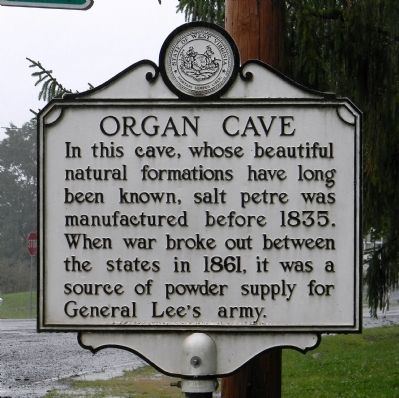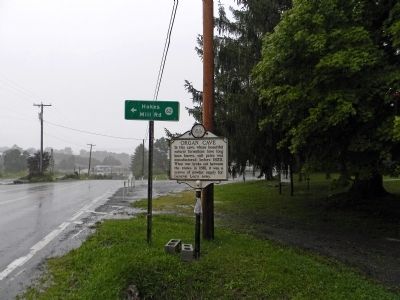Near Ronceverte in Greenbrier County, West Virginia — The American South (Appalachia)
Organ Cave
In this cave, whose beautiful natural formations have long been known, salt petre was manufactured before 1835. When war broke out between the states in 1861, it was a source of powder supply for General Lee's army.
Topics and series. This historical marker is listed in these topic lists: Environment • Industry & Commerce • Paleontology • War, US Civil. In addition, it is included in the West Virginia Archives and History series list. A significant historical year for this entry is 1835.
Location. 37° 42.755′ N, 80° 26.485′ W. Marker is near Ronceverte, West Virginia, in Greenbrier County. Marker is at the intersection of 219 and Hokes Mill Road (County Road 62), on the right when traveling west on 219. Touch for map. Marker is in this post office area: Ronceverte WV 24970, United States of America. Touch for directions.
Other nearby markers. At least 8 other markers are within 6 miles of this marker, measured as the crow flies. Confederate Saltpeter Works (approx. half a mile away); Ronceverte (approx. 2.9 miles away); Bread Tradition (approx. 2.9 miles away); The Hanging of David Creigh (approx. 3.9 miles away); Coffman (approx. 4.7 miles away); Berea Sand (approx. 5.4 miles away); Pontiac's War / Welsh Cemetery (approx. 5.7 miles away); Greenbrier Military School (approx. 5.9 miles away). Touch for a list and map of all markers in Ronceverte.
Also see . . .
1. Organ Cave. West Virginia Encyclopedia website entry:
Organ Cave has 11 entrances and is the second-largest cave in West Virginia with about 40 miles of surveyed passages. (Submitted on August 24, 2014, by PaulwC3 of Northern, Virginia.)
2. Organ Cave - National Register of Historic Places Nomination Form. West Virginia Department of Arts, Culture and History website entry (Submitted on August 24, 2014, by PaulwC3 of Northern, Virginia.)
3. Organ Cave, A National Landmark In West Virginia!. Website homepage:
Organ Cave has played a significant role in the American history as well as providing a living laboratory for scientists in the fields of geology, archeology, biology, hydrology and paleontology. (Submitted on August 24, 2014, by PaulwC3 of Northern, Virginia.)
Credits. This page was last revised on January 25, 2022. It was originally submitted on August 24, 2014, by PaulwC3 of Northern, Virginia. This page has been viewed 626 times since then and 18 times this year. Photos: 1, 2. submitted on August 24, 2014, by PaulwC3 of Northern, Virginia.

